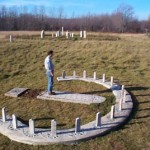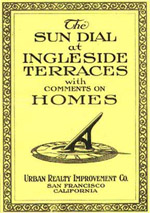
The sundial that was, and is, in Ingleside Terrace. Note the shallow reflecting pool underneath the original sundial.
As modern humans, we usually think time is about minutes and seconds and not being late for a meeting. But really, time is all about the position of the sun relative to the Earth. I love sundials because they’re a reminder that the entity we try to manage, control, spend less of, and schedule our lives by is actually tied to something in nature.

You can be the time-telling shadowcaster in a sundial.
Over the course of the day, shadows shorten and lengthen as the angle of the light changes. The length and angle of a shadow depends on where the sun is. A sundial tells us what time it is by capturing the regular path the sun follows across the sky each day.
Not only can the sun tell us what time it is, it can tell us what direction we’re facing. How? Put a stick in the ground and mark the end of its shadow. Wait 15 minutes or so, and mark the shadow’s end again. Draw a straight line between the two marks. The left end of the line is west, the right end is east. Face the line and you’ll be facing north. Good to know if you’re an adventurous trekker whose GPS batteries run out.
Why does this work? Because the time of day and the position of the earth relative to the sun are actually the same thing.
Perhaps our attraction for sundials is more aesthetic then scientific, though. The sundial above was created in 1913 in an effort to lure home buyers to a posh then-new development in the foggy Ingleside neighborhood of San Francisco. The New York Times picked up a short ditty on the sundial this weekend from Bay Citizen, a local news org partnered with the Times.
Or better yet, check out the original brochure for the neighborhood attraction on the website of the Western Neighborhoods Project–the original Outsidelands, before that silly rock festival co-opted the name.




 D-Street in the
D-Street in the  Check out the profile of Discovery Street on Nature Blogs!
Check out the profile of Discovery Street on Nature Blogs! Are you a member of KQED? Discovery Street Tours are a member discount perk! Visit the
Are you a member of KQED? Discovery Street Tours are a member discount perk! Visit the